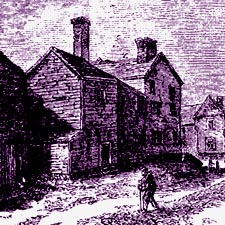|
FRESH STUFF DAILY |
|
|
||
|
|
||
|
|
||
|
SEE ALL SIGNED BOOKS by J. Dennis Robinson click here |
||
Page 1 of 3
READ MORE NH Black History stories The local tavern was a key building in colonial life and the tavern keepers were at the center of the action. This was especially true for the Stavers (or Stayers) family who owned their public house during the confusing days of the American Revolution. John Hancock, William Whipple, Lafayette, perhaps George Washington moved through these rooms. So too did slaves like James and Fortune, names nearly lost to history, but for the research and teaching of Valerie Cunningham. Today the restored William Pitt Tavern is open to visitors of Strawbery Banke Museum. But it is also an important stop along the Portsmouth Black Heritage Trail, not as the birthplace of the Masonic Lodge or the home of the Portsmouth Flying Stagecoach -- but as the home of a northern slave owner and slave trader. Here is that story. (JDR) SLAVES AT THE WILLIAM PITT TAVERN Overview: Slaves and the Stavers Family This three-story tavern was built at Court and Atkinson Street in Portsmouth, NH as the Earl of Halifax Tavern in 1766 by English immigrant John Stavers (or Stayers) and his second wife Katherine, a Portsmouth native. They re-named the business the William Pitt Tavern during the 1770s. Their household included up to seven children and, at various times, one or two slaves. Africans wove in and out of Stavers' life. Back in the 1750s Stavers had a violent encounter with a slave when at sea. In 1760 Stavers hosted a slave auction (in his previous tavern on State Street. In 1764, just before the Stavers moved, a sixteen-year-old slave named Fortune was part of their household. In 1777, at this new tavern, a slave named James was part of the Stavers household. Another slave, not owned by Stavers, was exhibited to public view as a curiosity. The Incident at Sea Tavern-keeping was a second career for John Stavers. In 1752, when he was the Mate on board the "Princess Dowager" sailing from St. Christopher (St. Kitts, West Indies) under Captain Nathaniel Warner, Stavers beat the captain's Negro servant, for which he was subsequently taken to court. Little is known about this incident, but it establishes Stavers' subsequent relations to Africans. An Auction at the Tavern Before moving their business to the present building on the corner of Court and Atkinson, the Staverses ran a tavern on State Street. In December of 1760 they advertised an upcoming sale of slaves: "To be sold...a few Negroes, lately imported in the snow Gen. Townshend...from the West Indies...at Stavers Tavern". Perhaps it was at this or a similar sale that Stavers purchased Fortune and James. Domestic Tasks Fortune and James probably worked beside the Stavers family in the routines of operating the tavern. The tavern was licensed to lodge guests and serve food and alcohol. Food had to be procured, preserved, stored, retrieved, cooked, served, presented, and the dishes and kitchen cleaned. In the tap room liquor, fruits, and sugar had to be procured, stored, mixed, served, and glasses, punch bowls and tankards cleaned. Rooms had to be cleaned, and laundry washed. Firewood had to be procured, stacked, split and distributed year 'round. Fires had to be maintained, ash cleaned out, candles purchased, distributed, collected and trimmed. Care was needed for traveller's horses and the horses of the Boston stage-coach line (which came to this tavern). Stavers also advertised stallions standing at stud. Procuring hay and straw, feeding, brushing and bedding horses, mucking out stables, and periodically hauling away manure added to the list of tasks. In addition, the tavern was the site of occasional military enlistments, and drew crowds for auctions, concerts, masonic meetings and banquets, all of which generated special tasks of preparation, implementation, and clean-up. Given the scale of the tavern operation and New England tradition it is likely that all the Staverses -- adults, children, and slaves -- worked together at necessary tasks, assigned by Mr. and Mrs. Stavers. CONTINUE to read about runaway slaves, a man hit by an ax, thievery and the albuni slave
Please visit these SeacoastNH.com ad partners.
News about Portsmouth from Fosters.com |
| Thursday, April 18, 2024 |


|
Copyright ® 1996-2020 SeacoastNH.com. All rights reserved. Privacy Statement
Site maintained by ad-cetera graphics

 Stories
Stories



 NH BLACK HISTORY
NH BLACK HISTORY














